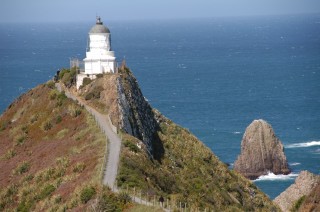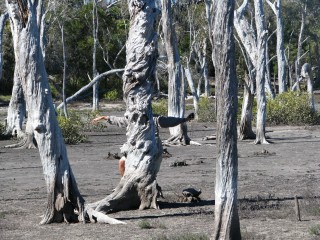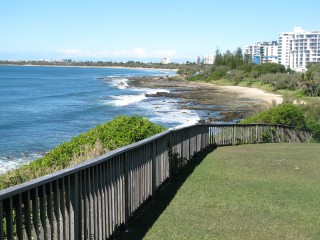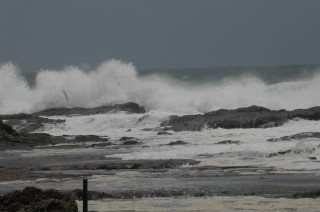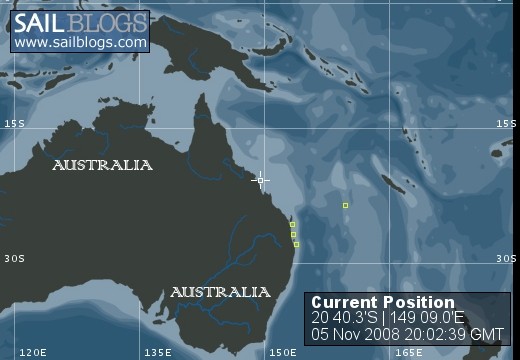
Silkie's Journal
05 November 2008
07 September 2008
02 August 2008 | Queensland, AU
17 May 2008 | Lat 27 48'S; Long 153 26'E
26 October 2007 | Lat 23 24'S Long 159 19'E
01 September 2007 | Lat 13 17'S Long 163 54'W
01 July 2007 | Lat 17 34'S Long 149 37'W
11 May 2007 | Lat 0 45'S Long 90 18'W
13 April 2007 | Lat 08 56'N, Long 79 33'W
24 March 2007 | Lat 09 19'N, Long 80 00'W
11 February 2007 | Lat 15 50'N, Long 88 44' W
Sailing between Suwarrow and Pago Pago, Am. Samoa
01 September 2007 | Lat 13 17'S Long 163 54'W
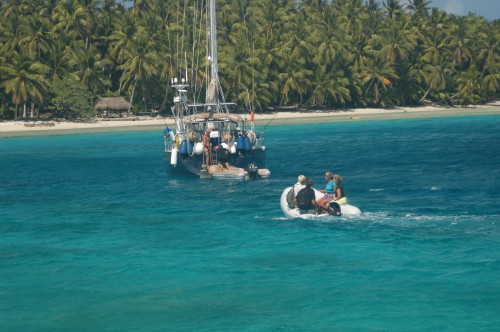
When I wrote last time, we had just arrived at Papeete, Tahiti and were anchored near Taina Marina, the biggest, fanciest marina in the region. As it turns out, we became very familiar with Taina Marina, because several friends were docked there, and because we stayed longer then we should have or wanted to because of battery problems. These problems started between the Galapagos and Marquesas when we noticed that we needed to charge the batteries sooner then before and found in the course of things that one of the four batteries was not doing well, i.e. it couldn't hold a charge. We ended up running the boat on � of our house battery bank. This is a 24 volt boat so that two 12 volt Northstar batteries make up one 24 volt pair and the third and forth batteries make up the second 24 volt pair, therefore if one 12 volt battery goes down we have actually lost � our battery bank. We limped along OK except we were using our engines to charge the remaining batteries at least once a day to operate the autopilot, lights, computers, etc. assisted by the 12 solar panels. We really don't want to use the engines to do this. So we called up the NorthStar battery guy to complain and a month later, after much hee-ing and haw-ing he arranged to send us a warranty replacement battery. No sweat, right? The battery, all 138 lbs. of it, was sent from a dealer in Vancouver BC, a really great place, no doubt, but not if you're in French Polynesia and they're shipping it by UPS. We love UPS. In the States. Great Service. But not out here. It left Vancouver BC on July 12, promised to arrive in Papeete by July 24th, was misdirected to somewhere in California, then went to Louisville KY where it sat in Customs for five days, then (after we called) went to California again, then to Hawaii, then to Sydney, then to Auckland, then sat a week in Auckland because UPS only flies to Tahiti on Saturdays, then finally to Tahiti (on Saturday) and finally out of customs and to us on Tuesday, August 7, 2007. Cost to us? $1,540.00 US, I kid you not. Moral of the story: when in the South Pacific, do not use UPS. Use DHL or FedEx.
So here we were in Papeete, a very cosmopolitan city, quite French. We spent the first several days learning all about that section of town where the marine suppliers reside, poor as they are. Our windlass had recently become problematic so we took (i.e. carried, on foot) the motor to the folks at Dieselec who took it apart, found the problem, told us it was not repairable and didn't charge us anything. We ordered a new one from New Zealand which was delivered in less then a week by DHL. It was exactly the right motor, problem solved. To say that marine supplies are hard to find in Papeete would be an understatement- anything of any substance must be ordered from elsewhere, usually NZ or the States at significant shipping cost.
While waiting around at anchor, we explored other parts of Papeete. We got into town, about 5 miles from the marina, by riding in Le Truck. These are trucks with the back removed and replaced with a wooden structure with bench seats along each side and one down the middle. It cost 130 CPF (about $1.50 US) to go any distance at all, one block or all the way into town. They run frequently and are easy to flag down anywhere. Downtown is crowded, noisy and alive; lots of places to eat if you want to go broke quickly or you can get a very nice baguette sandwich for 300-400 CPF, a coke for 140 CPF and a delicious French pastry for 100 CPF at the central market as well as really fresh vegetables, absolutely exquisite fresh flower arrangements, ice cream, jewelry, wood carvings, and other touristy do-dads. We ate there whenever we were in town at lunch time. I will always remember this about Papeete: all cars stop dead in their tracks whenever a pedestrian steps into a cross-walk. Cool. We had heard that the main artery in Papeete which skirts the harbor would be crowded with boats med-moored all along it. Not so. We walked along the edge of the harbor and saw two boats there- one of them a 37 ft Pacific Seacraft named Journey, from Chocowinity NC. How's that for small world department? But why not crowded?? We heard that they had recently started charging a higher price for dockage there and the boats simply went elsewhere. Of course, the crowded days may have predated the relatively new Marina Taina. This marina is very unlike US marinas. It has no slips, no finger piers. Most of its 400-500 spaces along its several floating concrete docks are occupied with med-moored boats (with a few side-ties) from 20 ft runabouts to megayachts, with the smaller boats on the inside and the megayachts on the outside dock. The big boys (sail and power from 100-150 feet LOA) are stern to the dock with the bow held out with anchor chain and four heavy lines which attach to very large concrete blocks positioned at least 150-200 feet out from the dock in about 60 feet of water!. Getting docked here requires the assistance of a scuba diver to set the bow lines.
We took a road tour of the interior of Tahiti. There is very little going on in the interior. Only one road goes to the center of the island and dead ends there. We saw several very tall waterfalls, even though it is the dry season. I can't imagine what it would be like in the rainy season. The greenery is beautiful, the topography grand, the roads require a 4 wheel vehicle. Aside from that, not much.
After about two weeks in Papeete, we sailed to Moorea, a smaller island about 10 nm from Tahiti. There are two large bays on the north side of the island, Cooks Bay and Opunohu Bay which are favorite anchorages for cruisers. We anchored in Opunohu Bay, near the entrance; in 25 feet of crystal clear water (hereinafter CCW) about 500 feet off a public beach of white sand and palm trees. The holding was very good and we spent a very delightful three and a half weeks there. Moorea is the one place we have been to so far that I would recommend to anyone who is looking for a high-class resort-type vacation spot. The island is physically stunning, the resorts are top-notch. There is shopping for pearls, wood carvings, jewelry, etc. on the island, snorkeling and diving are big there too. The water and scenery are picture-post-card real. We grocery shopped at two small groceries in a little town about 15 minutes away by dingy. This is where we really learned how to read the navigation buoys and you better be able to do that because the outside barrier reef is not the only reef to watch out for. French Polynesia follows red-left-returning (Region A), opposite from our "red-right- returning" Region B, so that when returning to an island through a barrier reef you keep red to port, green to starboard. When negotiating the areas between the land and the outer reef, there are red and green inner passage markers: red on the island side and green on the seaward side of the channel. Then there are cardinal marks which indicate navigable waters on the named side of the mark (i.e. N, S, E, and W). There are also white and black poles stuck in concrete which get you around certain shallow areas. It took me awhile to be at ease while we zoomed full speed around these areas carefully following the markers but looking down to see coral seemingly within inches of our dingy's. keel.
While we were at Opunohu Bay a friend came down with what seemed at first like the same bug John and I had fallen prey to and survived when we were in Rangiroa. Turns out it was not so simple and she ended up in the hospital. We helped her get to the local doctor and he sent her to the hospital. She ended up staying for about 10 days and really needed to be there. We looked after their boat while hubby stayed with her. We had heard that Tahiti has an excellent health care system and that was confirmed by Carmen's experience. We were saddened to hear that a tragedy struck Moorea about two weeks after we were there: the local inter-island plane crashed on take-off, killing all 20 people aboard. The whole area was shaken by this as some VIPs and local dignitaries were lost.
FINALLY hearing that our battery was actually on the way, we returned to Papeete and dropped the hook at Taina Marina again but this time at the other end of the anchorage in 10 feet of CCW, a very nice spot to be. This was my last chance to go to the large and complete Carrefour supermarket for cheese and veggies and other nice things and to do a clothes wash at the marina laundry. Those chores dispatched with, we finally got on the road and sailed NW 190 nm to Raiatea, another beautiful island in the same group but where almost all the anchorages are very deep. We spend one night on a mooring (in 90 feet of water) and then sailed the last 18 nm to Bora Bora.
Bora Bora is as pretty in person as it is in the picture post-cards. We spent two nights anchored off Bloody Mary's, a favorite bar-restaurant for cruisers where you can dispose of your trash and get big bags of ice free. However, the wind was honkin' and we were in 75 feet of water so we moved around to the back side (i.e. west side) of Moto Toopua which is inside the BB barrier reef. There we found a spot in 10 ft of CCW with several friend-boats and spent a very delightful week. At one point there were 40 cruisers anchored behind Moto Toopua. BB is big-time tourist island and yet quite cruiser friendly with a fuel dock and a place there to leave your dingy while you shop for groceries at a complete, though dusty, grocery one block down the road. It also has several nice eating places and a small boat harbor with trash barrel.
After spending 11 pleasant days at BB, it was time to move on . Our next stop was the atoll of Suwarrow (aka Suvarov) Atoll, Cook Islands, about 680 nm west of BB (and 480 nm east of Pago Pago, American Samoa, truly in the middle of nowhere.) We covered that in 5 days of easy downwind sailing, slowing down at the end to time our arrival for about 9:00 AM local so we could see to go through the pass. Our electronic charts were spot on and we had no trouble getting through the pass safely. We anchored in 20 feet of CCW in a coral field, there being nothing but coral in the anchorage. Suwarrow Atoll is 11 miles across and is shaped like a squared circle with one entrance on the north side. It is a National Park and is uninhabited except for the care-taker who lives there from May to October. John, from Raratonga, has been care-taker for three years now and this year brought his four young boys as well as his wife, Veronica. The whole family is delightful. Veronica does the check-ins which included payment of $50 and a reading of the "rules" all of which are designed to protect the atoll and the cruisers on it. We took a day trip to Bird Island and Seven Island, led by John and family and a few days later other cruisers took a day trip to Turtle Island. In the week we were there we had pot-luck suppers on the beach every night with the main entr�e being fresh fish caught by cruisers or by John. Veronica cooked delicious coconut pancakes made with the soft pulp of green coconuts. A good time was had by all and I found that I like grouper and mahi mahi very much. When we left this morning there were 17 boats anchored off the jetty built by Tom Neale of Suwarrow fame. Suwarrow certainly is a very special place.
So here we are, course 251, wind 15 knots/ ESE, SOG about 7 kts, seas 6-8, 430 nm to go to Pago Pago, night is coming. All is well.
'Till Next Time
Susan.
So here we were in Papeete, a very cosmopolitan city, quite French. We spent the first several days learning all about that section of town where the marine suppliers reside, poor as they are. Our windlass had recently become problematic so we took (i.e. carried, on foot) the motor to the folks at Dieselec who took it apart, found the problem, told us it was not repairable and didn't charge us anything. We ordered a new one from New Zealand which was delivered in less then a week by DHL. It was exactly the right motor, problem solved. To say that marine supplies are hard to find in Papeete would be an understatement- anything of any substance must be ordered from elsewhere, usually NZ or the States at significant shipping cost.
While waiting around at anchor, we explored other parts of Papeete. We got into town, about 5 miles from the marina, by riding in Le Truck. These are trucks with the back removed and replaced with a wooden structure with bench seats along each side and one down the middle. It cost 130 CPF (about $1.50 US) to go any distance at all, one block or all the way into town. They run frequently and are easy to flag down anywhere. Downtown is crowded, noisy and alive; lots of places to eat if you want to go broke quickly or you can get a very nice baguette sandwich for 300-400 CPF, a coke for 140 CPF and a delicious French pastry for 100 CPF at the central market as well as really fresh vegetables, absolutely exquisite fresh flower arrangements, ice cream, jewelry, wood carvings, and other touristy do-dads. We ate there whenever we were in town at lunch time. I will always remember this about Papeete: all cars stop dead in their tracks whenever a pedestrian steps into a cross-walk. Cool. We had heard that the main artery in Papeete which skirts the harbor would be crowded with boats med-moored all along it. Not so. We walked along the edge of the harbor and saw two boats there- one of them a 37 ft Pacific Seacraft named Journey, from Chocowinity NC. How's that for small world department? But why not crowded?? We heard that they had recently started charging a higher price for dockage there and the boats simply went elsewhere. Of course, the crowded days may have predated the relatively new Marina Taina. This marina is very unlike US marinas. It has no slips, no finger piers. Most of its 400-500 spaces along its several floating concrete docks are occupied with med-moored boats (with a few side-ties) from 20 ft runabouts to megayachts, with the smaller boats on the inside and the megayachts on the outside dock. The big boys (sail and power from 100-150 feet LOA) are stern to the dock with the bow held out with anchor chain and four heavy lines which attach to very large concrete blocks positioned at least 150-200 feet out from the dock in about 60 feet of water!. Getting docked here requires the assistance of a scuba diver to set the bow lines.
We took a road tour of the interior of Tahiti. There is very little going on in the interior. Only one road goes to the center of the island and dead ends there. We saw several very tall waterfalls, even though it is the dry season. I can't imagine what it would be like in the rainy season. The greenery is beautiful, the topography grand, the roads require a 4 wheel vehicle. Aside from that, not much.
After about two weeks in Papeete, we sailed to Moorea, a smaller island about 10 nm from Tahiti. There are two large bays on the north side of the island, Cooks Bay and Opunohu Bay which are favorite anchorages for cruisers. We anchored in Opunohu Bay, near the entrance; in 25 feet of crystal clear water (hereinafter CCW) about 500 feet off a public beach of white sand and palm trees. The holding was very good and we spent a very delightful three and a half weeks there. Moorea is the one place we have been to so far that I would recommend to anyone who is looking for a high-class resort-type vacation spot. The island is physically stunning, the resorts are top-notch. There is shopping for pearls, wood carvings, jewelry, etc. on the island, snorkeling and diving are big there too. The water and scenery are picture-post-card real. We grocery shopped at two small groceries in a little town about 15 minutes away by dingy. This is where we really learned how to read the navigation buoys and you better be able to do that because the outside barrier reef is not the only reef to watch out for. French Polynesia follows red-left-returning (Region A), opposite from our "red-right- returning" Region B, so that when returning to an island through a barrier reef you keep red to port, green to starboard. When negotiating the areas between the land and the outer reef, there are red and green inner passage markers: red on the island side and green on the seaward side of the channel. Then there are cardinal marks which indicate navigable waters on the named side of the mark (i.e. N, S, E, and W). There are also white and black poles stuck in concrete which get you around certain shallow areas. It took me awhile to be at ease while we zoomed full speed around these areas carefully following the markers but looking down to see coral seemingly within inches of our dingy's. keel.
While we were at Opunohu Bay a friend came down with what seemed at first like the same bug John and I had fallen prey to and survived when we were in Rangiroa. Turns out it was not so simple and she ended up in the hospital. We helped her get to the local doctor and he sent her to the hospital. She ended up staying for about 10 days and really needed to be there. We looked after their boat while hubby stayed with her. We had heard that Tahiti has an excellent health care system and that was confirmed by Carmen's experience. We were saddened to hear that a tragedy struck Moorea about two weeks after we were there: the local inter-island plane crashed on take-off, killing all 20 people aboard. The whole area was shaken by this as some VIPs and local dignitaries were lost.
FINALLY hearing that our battery was actually on the way, we returned to Papeete and dropped the hook at Taina Marina again but this time at the other end of the anchorage in 10 feet of CCW, a very nice spot to be. This was my last chance to go to the large and complete Carrefour supermarket for cheese and veggies and other nice things and to do a clothes wash at the marina laundry. Those chores dispatched with, we finally got on the road and sailed NW 190 nm to Raiatea, another beautiful island in the same group but where almost all the anchorages are very deep. We spend one night on a mooring (in 90 feet of water) and then sailed the last 18 nm to Bora Bora.
Bora Bora is as pretty in person as it is in the picture post-cards. We spent two nights anchored off Bloody Mary's, a favorite bar-restaurant for cruisers where you can dispose of your trash and get big bags of ice free. However, the wind was honkin' and we were in 75 feet of water so we moved around to the back side (i.e. west side) of Moto Toopua which is inside the BB barrier reef. There we found a spot in 10 ft of CCW with several friend-boats and spent a very delightful week. At one point there were 40 cruisers anchored behind Moto Toopua. BB is big-time tourist island and yet quite cruiser friendly with a fuel dock and a place there to leave your dingy while you shop for groceries at a complete, though dusty, grocery one block down the road. It also has several nice eating places and a small boat harbor with trash barrel.
After spending 11 pleasant days at BB, it was time to move on . Our next stop was the atoll of Suwarrow (aka Suvarov) Atoll, Cook Islands, about 680 nm west of BB (and 480 nm east of Pago Pago, American Samoa, truly in the middle of nowhere.) We covered that in 5 days of easy downwind sailing, slowing down at the end to time our arrival for about 9:00 AM local so we could see to go through the pass. Our electronic charts were spot on and we had no trouble getting through the pass safely. We anchored in 20 feet of CCW in a coral field, there being nothing but coral in the anchorage. Suwarrow Atoll is 11 miles across and is shaped like a squared circle with one entrance on the north side. It is a National Park and is uninhabited except for the care-taker who lives there from May to October. John, from Raratonga, has been care-taker for three years now and this year brought his four young boys as well as his wife, Veronica. The whole family is delightful. Veronica does the check-ins which included payment of $50 and a reading of the "rules" all of which are designed to protect the atoll and the cruisers on it. We took a day trip to Bird Island and Seven Island, led by John and family and a few days later other cruisers took a day trip to Turtle Island. In the week we were there we had pot-luck suppers on the beach every night with the main entr�e being fresh fish caught by cruisers or by John. Veronica cooked delicious coconut pancakes made with the soft pulp of green coconuts. A good time was had by all and I found that I like grouper and mahi mahi very much. When we left this morning there were 17 boats anchored off the jetty built by Tom Neale of Suwarrow fame. Suwarrow certainly is a very special place.
So here we are, course 251, wind 15 knots/ ESE, SOG about 7 kts, seas 6-8, 430 nm to go to Pago Pago, night is coming. All is well.
'Till Next Time
Susan.
Comments
| Vessel Name: | Silkie |
| Vessel Make/Model: | CW54 Catamaran |
| Hailing Port: | Oriental, North Carolina |
| Crew: | Susan and John Fisher |
Silkie at Nuku Hiva
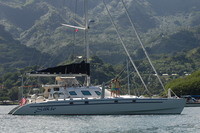
Who: Susan and John Fisher
Port: Oriental, North Carolina
Current Position
Favorite Links
No Links Added Yet
